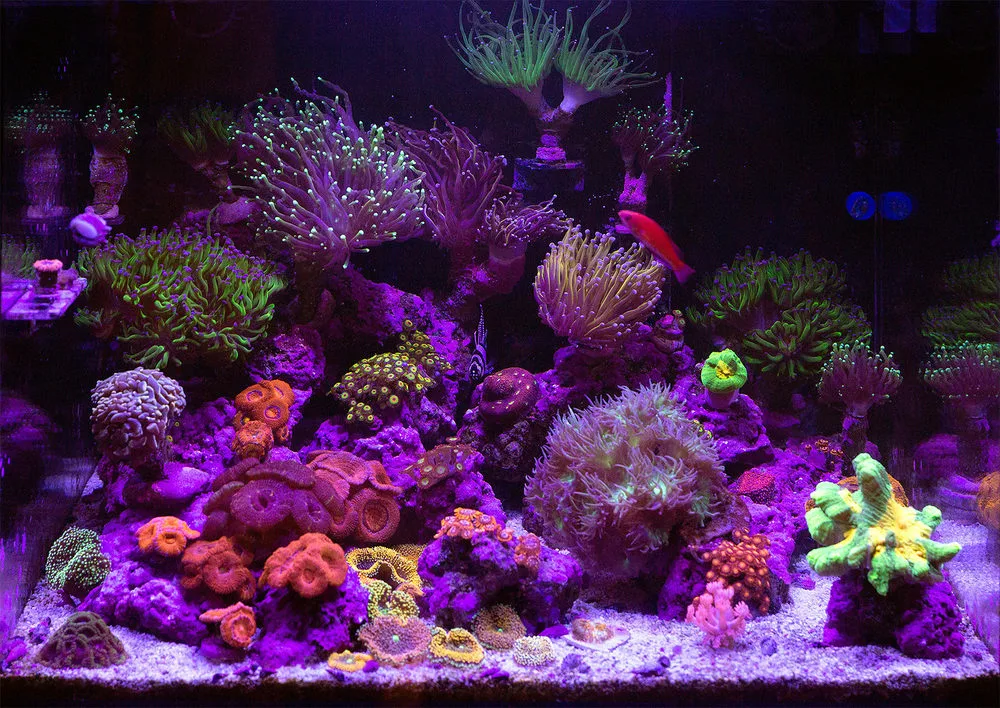Stunning 43-Gallon Reef Tank – burtbollinger's TOTM | NanoReef

Tank Specifications
Volume: 43 Gallons / 162 Liters
Dimensions (L × W × H):
40.0" ×
20.0" ×
21.5"
102.0cm ×
50.0cm ×
55.0cm
Equipment List
- Salt: Fritz
Frequently Asked Questions
What type of lighting is used in the tank, and how is it set up?
The tank uses a NanoBox Duo light mounted on a 15-inch gooseneck. The lighting is currently set at 75% blue and 15% white to provide adequate illumination for the LPS corals and maintain color vibrancy.
What filtration system is in place for this reef tank?
The filtration system includes a Bubble Magus Curve 5 skimmer and a Red Sea mesh filter sock that is swapped out about once a week. Additionally, Media such as Purigen and Marinepure are utilized for water clarity and biological filtration.
How is temperature controlled in the tank?
Temperature is controlled using an Eheim JAGER TruTemp heater and monitored by a Reefkeeper Lite controller, which provides heater protection and maintains a stable environment for the corals.
What type of water movement is ideal for this setup?
The tank employs two Vortech MP-10 pumps set to their lowest speed for gentle circulation, along with a Sicce Syncra 2.0 return pump to ensure adequate water movement throughout the tank.
What is the recommended routine for water changes?
Water changes should be done approximately every three weeks, with 8 gallons changed each time. It's essential to avoid exceeding a month between changes to prevent phosphate issues and maintain water quality.
How often should I test the water parameters?
You should test alkalinity about once a week to maintain it between 7.7 and 9, aiming for a target of 8.7. Calcium can be tested every 3-4 months, while nitrates should also be checked during that timeframe.
What is the best way to maintain substrate health?
It's best to gently stir the sandbed once every month or two and to avoid vacuuming it. Replace portions of the sand if there are patches of cyanobacteria due to overfeeding.
How often should I manually dose my tank, and what should I use?
You should manually dose a 2-part solution at 7.5 mL every 2-3 days to maintain alkalinity at around 8.5. Testing alkalinity frequently in the beginning will help you determine your dosing rate as you learn your tank's needs.
What kinds of food should be fed to the corals and fish in the tank?
Feed corals with Benereef once a week, along with occasional use of Reef Roids and LRS Reef Frenzy Nano. Fish can be fed a variety of high-quality foods, including LRS, to promote healthy growth and color.
What precautions should I take when adding new corals to the tank?
It's crucial to dip any new corals in iodine or a similar treatment to eliminate potential pests. Observe the new coral for signs of stress or disease, and be ready to remove it if it doesn't bounce back within a few days.
How do I handle a coral that is not doing well?
If a coral shows signs of distress, take immediate action instead of waiting. Assess its condition, consider dipping it, and if it fails to recover promptly, it's better to remove it from the tank rather than risk affecting the overall health of the tank.